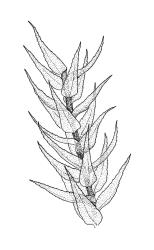Plants small to robust, dark, bright, or yellow-green, dull or lustrous, forming wefts or mats. Stems creeping or ascendant, irregularly or pinnately branched, with ascendant branches, in cross-section with a strong central strand, with scattered fascicles of smooth, brown rhizoids on ventral surface. Stem and branch leaves mostly differentiated in form, occasionally only by size. Stem leaves spreading, often widely so, sometimes appressed at base, not complanate, broadly ovate to broadly triangular from a broad insertion, serrulate ± throughout, usually decurrent, ± concave and often plicate, plane at margins; costa stout and usually little tapered, with or without a terminal abaxial spine. Branch leaves smaller than stem leaves, erect to erect-spreading, complanate or not, mostly ovate to ovate-lanceolate, gradually or abruptly acute, ± concave, not or weakly decurrent, variably plicate, serrate or serrulate throughout; upper laminal cells ± linear, smooth, ± thick-walled, eporose, those at leaf apex usually much shorter; alar cells not or weakly differentiated; costa stout and usually little tapered, usually projecting as one (or few) terminal abaxial spine. Paraphyllia rare (none in N.Z. species). Pseudoparaphyllia present, foliose.
Dioicous or less often autoicous. Perichaetial leaves wide-spreading to squarrose, costate or not. Setae elongate, slender or stout, scabrose throughout or less often smooth; capsules inclined or horizontal, asymmetric, ovoid-cylindric or short cylindric, dark; exothecial cells oblong, firm- or thick-walled, not or weakly collenchymatous; stomata present; annulus well developed; operculum long-rostrate from a conic base. Exostome teeth red-brown below, shouldered, bordered, cross-striate or cross-striolate below on outer surface, pale and papillose above; endostome well developed, with a high basal membrane; segments nearly the length to the teeth, keeled, perforate or gaping; cilia present, mostly nodose. Calyptra cucullate, smooth.
There is little consensus concerning either the generic limits or the number of species in Eurhynchium. The genera Kindbergia Ochyra [=Stokesiella H.Rob., hom. illeg.], Oxyrrhynchium (Schimp.) Warnst., are variously treated as synonyms or as generic segregates (cf. Smith 2004; Fife 1995) of Eurhynchium. These genera are not accepted here, and the clarification of the limits of Eurhynchium are outside the ambit of this eFlora. The broad view of the genus conforms with the concepts presented by Buck (1998, p. 245) for the West Indies and Hedenäs (2002) for Australia. The latter author considered Eurhynchium to encompass 65–70 species.
Among the Brachytheciaceae, Eurhynchium is characterised by having short cells at the mostly broad apex of the branch leaves, branch leaf costa terminating in an abaxial spine, and a long-rostrate operculum. Stem and branch leaves are generally strongly differentiated, but this is not the case in E. asperipes. Buck (1998, p. 245) considers that the very stout and relatively untapered costa of the branch leaves gives further definition to the genus, but this is not a feature of the two indigenous N.Z. species, suggesting that further study may be warranted.
The species treated as Kindbergia praelonga (Hedw.) Ochyra in Fife (1995) is accepted here as a Eurhynchium.
| 1 | Stem and branch leaves differing by size only; branch leaf apices pointed toward the branch apex and nearly parallel to the branch axis when moist, often twisted when dry; plants suggestive of a miniature Ptychomnion aciculare | E. asperipes |
| 1' | Stem and branch leaves differing by shape and size; branch leaf apices neither parallel to the branch axis when moist nor twisted when dry; plants not suggestive of a miniature Ptychomnion aciculare | 2 |
| 2 | Stem leaves strongly decurrent; dioicous; very common and weedy throughout N.Z. | E. praelongum |
| 2' | Stem leaves not or weakly decurrent; phyllodioicous, autoicous, or synoicous; less common and mostly in northern regions (but E. pulchellum known only from Somes I., Wellington L.D.) | 3 |
| 3 | Branch leaves complanate, c. 1.4 × 0.6 mm; branches ± uniform in length, giving the plants a neat appearance; mid laminal cells of stem leaves linear, mostly 120–165 × c. 6 µm; autoicous or synoicous; setae finely papillose throughout (usually not visible under hand-lens); northern N.Z. | E. speciosum |
| 3' | Branch leaves not or only weakly complanate, spreading, c. 0.8–0.9 × 0.3–0.4 mm; branches uneven in length; mid laminal cells of stem leaves shorter, mostly 30–45 × 6–9 µm; reportedly phyllodioicous; setae smooth, even under low objective of compound scope; known from Somes I., Wellington L.D | E. pulchellum |
| Category | Number |
|---|---|
| Indigenous (Non-endemic) | 1 |
| Exotic: Fully Naturalised | 3 |
| Total | 4 |
Eurhynchium cucullatum (Mitt.) I.G.Stone & G.A.M.Scott [J. Bryol. 7: 605, 1973] is treated here in the genus Scorpiurium, q.v.
Eurhynchium muriculatum (Hook.f. & Wilson) A.Jaeger, [Ber. Thätigk. St. Gallischen Naturwiss. Ges. 1876–77: 35, 1878] is treated here in the genus Rhynchostegium, q.v.
Eurhynchium novae-zealandiae (Dixon) Fife [Bryologist 98: 315, 1995] is treated here as a synonym of Rhynchostegium muriculatum, q.v.
Eurhynchium remotifolium (Grev.) A.Jaeger was reported from three N.Z. localities by Hooker (1867, as Hypnum remotifolium). This name is based on a South American type and is sometimes (e.g., Streimann & Curnow 1989) considered as a synonym of E. asperipes. Hedenäs (1996) excluded it from the Australian flora and commented on perceived differences between the two species. Eurhynchium remotifolium is not discussed further.




